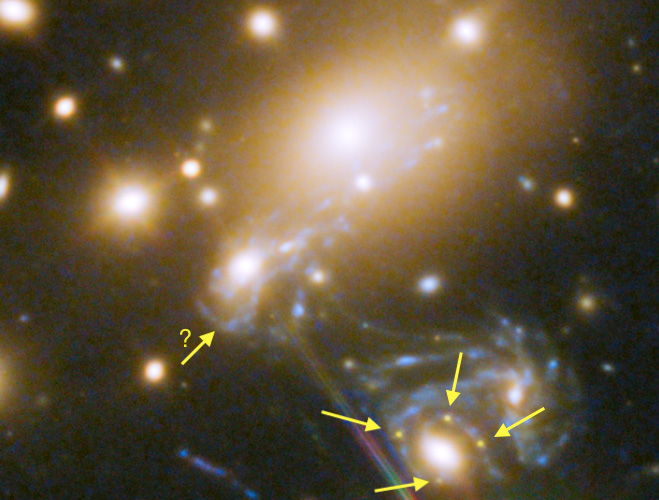Thanks to data from a magnified, multiply imaged supernova discovered by a team using the Hubble Space Telescope, a first-of-its-kind technique has been successfully used to measure the expansion rate of the Universe. The team includes Tom Broadhurst, Ikerbasque Research Professor of the UPV/EHU and Associate of the DIPC. This technique provides a new, independent insight into a longstanding debate and could help scientists determine the Universe’s age more accurately and understand the cosmos better.
Analysing light from a reappearing supernova provides a new value of the Universe’s expansion rate
A first-of-its-kind measurement of the Universe’s expansion rate, in which Professor Tom Broadhurst has participated, weighs in on a longstanding debate in physics and astronomy
- Research
First publication date: 22/02/2024
In astronomy, there are two precise measurements of the expansion of the Universe, also known as the “Hubble constant.” One is calculated from nearby observations of supernovae (the massive explosions that come at the end of the life cycle of some stars), and the second uses the “cosmic microwave background,” or radiation that began to stream freely through the Universe shortly after the Big Bang. However, these two measurements differ by about 10%, which has sparked widespread debate among physicists and astronomers. If both measurements are accurate, it means that the current theory held by scientists about the make-up of the universe is incomplete.
An international team, including the Ikerbasque Research Professor of the University of the Basque Country (UPV/EHU) and associate of the Donostia International Physics Center (DIPC) Tom Broadhurst, calculated a new estimate of the Hubble constant by analysing light from multiple appearances of a supernova.
“If new, independent measurements confirm this disagreement between the two measurements of the Hubble constant, it would become a chink in the armour of our understanding of the cosmos,” said Patrick Kelly, lead author of the study and an assistant professor at the University of Minnesota School of Physics and Astronomy. “The big question is if there is a possible issue with one or both of the measurements. Our research addresses that by using an independent, completely different way to measure the expansion rate of the Universe.”
The team calculated this expansion rate using data from the supernova Refsdal, the first ever example of a multiply imaged supernova, meaning that the telescope captured four different images of the same cosmic event. After the discovery, teams around the world predicted that the supernova would reappear at a new position in 2015, and the University of Minnesota team detected this additional image. These multiple images appeared because the supernova was gravitationally lensed by a galaxy cluster, a phenomenon in which mass from the cluster bends and magnifies light. By using the time delays between the appearances of the 2014 and 2015 images, the researchers were able to measure the Hubble Constant by using a theory developed in 1964 by Norwegian astronomer Sjur Refsdal and which had previously been impossible to put into practice.
Helping to understand the fundamental relations between dark matter and dark energy better
The new measurement of the Hubble constant tallies better with that from the cosmic microwave background, “by reinforcing our understanding that the expansion rate of the Universe is dominated by the outward pressure of dark energy, and compensated by the self-gravity of dark matter such that at the present time the expansion of the Universe is actually accelerating,” concluded Tom Broadhurst.
The research is divided into two papers, respectively published in Science and The Astrophysical Journal. It was funded primarily by NASA through the Space Telescope Science Institute and the National Science Foundation. The team included researchers from the University of Minnesota’s Minnesota Institute for Astrophysics; the University of South Carolina; the University of California, Los Angeles; Stanford University; the Swiss Federal Institute of Technology, Lausanne; Sorbonne University; the University of California, Berkeley; the University of Toronto; Rutgers University; the University of Copenhagen; the University of Cambridge; the Kavli Institute for Cosmology; Ben-Gurion University of the Negev; University of the Basque Country; the University of Cantabria; Consejo Superior de Investigaciones Cientificas (the Spanish National Research Council); the Observatories of the Carnegie Institution for Science; the University of Portsmouth; Durham University; the University of California, Santa Barbara; the University of Tokyo; the Space Telescope Science Institute; the Leibniz Institute for Astrophysics, Potsdam; the University of Michigan; Australian National University; Stony Brook University; Heidelberg University; and Chiba University.
Bibliographic reference
- Constraints on Hubble constant from Supernova Refsdal’s reappearance
- Science
- DOI: 10.1126/science.abh1322
- The Magnificent Five Images of Supernova Refsdal: Time Delay and Magnification Measurements
- The Astrophysical Journal
- DOI: 10.3847/1538-4357/ac4ccb



